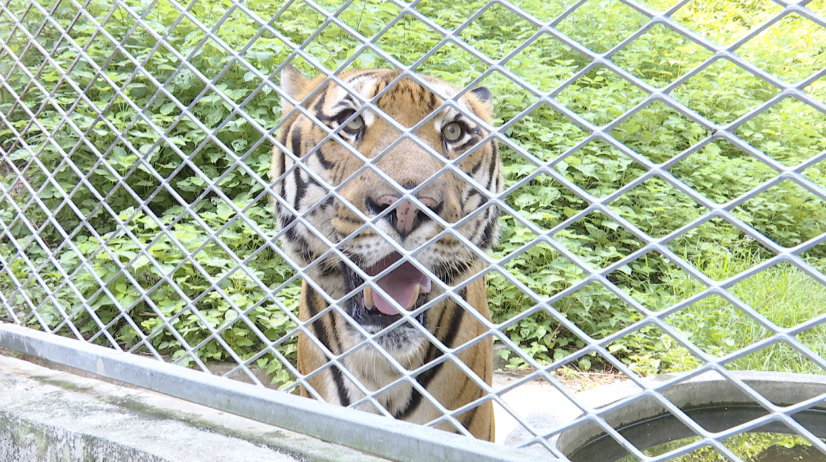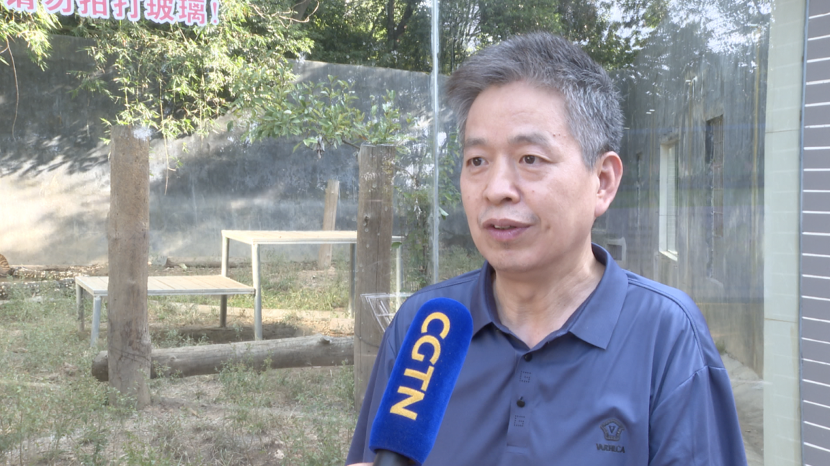October 4th marks World Animal Day, aimed at raising awareness about animal rights and welfare across the globe. The research and breeding base for South China tigers in Shaoguan, Guangdong Province is set to release a global petition on protecting the animal, which is one of the most endangered in the world.

A South China tiger staring at visitors from a cage at the research and breeding base of the South China tigers in Shaoguan. / CGTN
A South China tiger staring at visitors from a cage at the research and breeding base of the South China tigers in Shaoguan. / CGTN
The South China tiger is the only tiger subspecies native to China. Since the 1990s, it has been listed as critically endangered by the International Union for Conservation of Nature.
In the early 1950s, its population was at around 4,000, widely distributed in central, south and southwest China.
However, the habitat of the South China tiger was overtaken as the human population grew rapidly. Many tigers were forced to live and hunt around human residences… with many being killed after attacking people.
Since the last recorded sighting of the South China Tiger in Che-ba-ling National Nature Reserve in 1991, this species has not been seen in the wild in northern Guangdong Province.
Now, the only South China tigers left have been bred in captivity, with the number reaching over 200. But long captivity has suppressed their natural instincts.
To help restore the species' population in the wild, the research and breeding base of the South China tigers in Shaoguan has invited experts and scholars to design a "kindergarten" for tiger cubs. The base is also expected to release a global motion on protecting the subspecies.
“Growing up is very important phase of the life of the tiger as well. And so to think a little bit more about how we can build a kindergarten for tigers which develops concepts of animal parks a little bit further and maybe it's a little bit more natural to their habitat," said Alexander Glaser, Architect & Partner at Prespace Architects.
Many say it's important that Shaoguan has spent great effort to preserve the tigers and to build the population of the tigers.
“Tigers are an essential part of Chinese culture, they're central part of the nature, of Shaoguan district, and it's central part of Guangdong province and essential for China. So it's very important that they do that. I think the effort here is remarkable,”said Thomas Kvan, Founding Dean of Southern University of Science and Technology
Through the kindergarten, experts hope to raise the cubs so that they can ultimately be returned to the wild. However, it's never an easy task.
A tiger needs at least 70 square kilometers of forest for habitation. Releasing these tigers back into the wild requires protection of vast areas of forest and its ecological environment for the South China Tiger to survive.

Gong Zhihai, Director of South China Tiger Nature Reserve in Guangdong Province, talks about plans to release the South China Tiger to the wild. /CGTN
Gong Zhihai, Director of South China Tiger Nature Reserve in Guangdong Province, talks about plans to release the South China Tiger to the wild. /CGTN
Gong Zhihai, is Director of South China Tiger Nature Reserve in Guangdong Province.
He said that the main work right now is to expand the tiger population first, then gradually carry out some wildlife training for the existing tigers. A kindergarten is expected to provide basic physical training and skill training for the tiger cubs, to help them adapt to the wild in the future.
Based on the preliminary investigation of the technical expert team, Guangdong is planning to build the base to train these tigers to return to the wild in Ruyang Forest Farm in Shaoguan City due to its rich resources.
Gong says returning the South China tiger to the wild is a systematic process. Only after all the proper conditions are met can the South China tiger be released.
(If you want to contribute and have specific expertise, please contact us at nature@cgtn.com.)